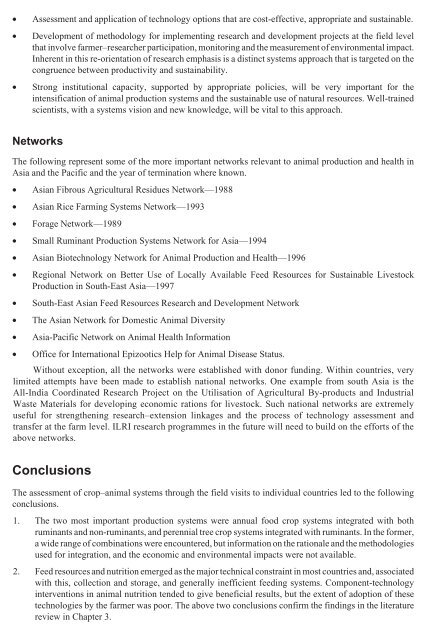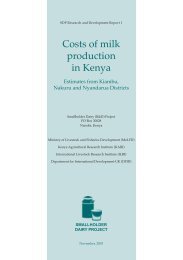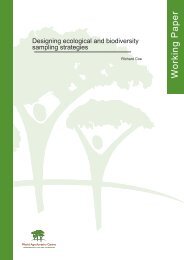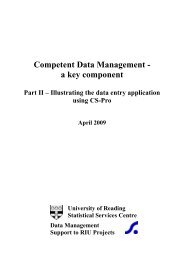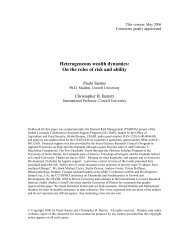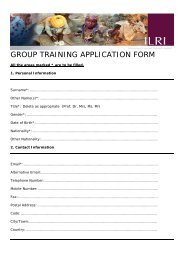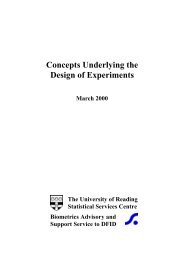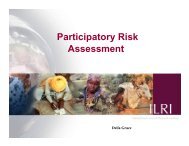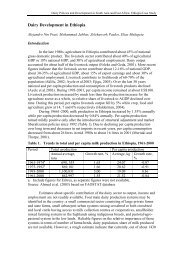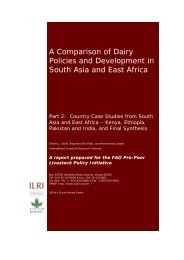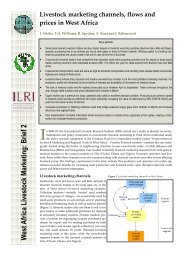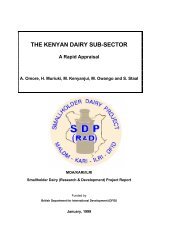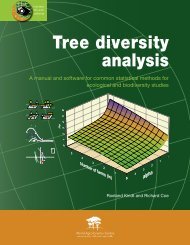Improvement of Livestock Production in Crop-Animal Systems in ...
Improvement of Livestock Production in Crop-Animal Systems in ...
Improvement of Livestock Production in Crop-Animal Systems in ...
Create successful ePaper yourself
Turn your PDF publications into a flip-book with our unique Google optimized e-Paper software.
• Assessment and application <strong>of</strong> technology options that are cost-effective, appropriate and susta<strong>in</strong>able.• Development <strong>of</strong> methodology for implement<strong>in</strong>g research and development projects at the field levelthat <strong>in</strong>volve farmer–researcher participation, monitor<strong>in</strong>g and the measurement <strong>of</strong> environmental impact.Inherent <strong>in</strong> this re-orientation <strong>of</strong> research emphasis is a dist<strong>in</strong>ct systems approach that is targeted on thecongruence between productivity and susta<strong>in</strong>ability.• Strong <strong>in</strong>stitutional capacity, supported by appropriate policies, will be very important for the<strong>in</strong>tensification <strong>of</strong> animal production systems and the susta<strong>in</strong>able use <strong>of</strong> natural resources. Well-tra<strong>in</strong>edscientists, with a systems vision and new knowledge, will be vital to this approach.NetworksThe follow<strong>in</strong>g represent some <strong>of</strong> the more important networks relevant to animal production and health <strong>in</strong>Asia and the Pacific and the year <strong>of</strong> term<strong>in</strong>ation where known.• Asian Fibrous Agricultural Residues Network—1988• Asian Rice Farm<strong>in</strong>g <strong>Systems</strong> Network—1993• Forage Network—1989• Small Rum<strong>in</strong>ant <strong>Production</strong> <strong>Systems</strong> Network for Asia—1994• Asian Biotechnology Network for <strong>Animal</strong> <strong>Production</strong> and Health—1996• Regional Network on Better Use <strong>of</strong> Locally Available Feed Resources for Susta<strong>in</strong>able <strong>Livestock</strong><strong>Production</strong> <strong>in</strong> South-East Asia—1997• South-East Asian Feed Resources Research and Development Network• The Asian Network for Domestic <strong>Animal</strong> Diversity• Asia-Pacific Network on <strong>Animal</strong> Health Information• Office for International Epizootics Help for <strong>Animal</strong> Disease Status.Without exception, all the networks were established with donor fund<strong>in</strong>g. With<strong>in</strong> countries, verylimited attempts have been made to establish national networks. One example from south Asia is theAll-India Coord<strong>in</strong>ated Research Project on the Utilisation <strong>of</strong> Agricultural By-products and IndustrialWaste Materials for develop<strong>in</strong>g economic rations for livestock. Such national networks are extremelyuseful for strengthen<strong>in</strong>g research–extension l<strong>in</strong>kages and the process <strong>of</strong> technology assessment andtransfer at the farm level. ILRI research programmes <strong>in</strong> the future will need to build on the efforts <strong>of</strong> theabove networks.ConclusionsThe assessment <strong>of</strong> crop–animal systems through the field visits to <strong>in</strong>dividual countries led to the follow<strong>in</strong>gconclusions.1. The two most important production systems were annual food crop systems <strong>in</strong>tegrated with bothrum<strong>in</strong>ants and non-rum<strong>in</strong>ants, and perennial tree crop systems <strong>in</strong>tegrated with rum<strong>in</strong>ants. In the former,a wide range <strong>of</strong> comb<strong>in</strong>ations were encountered, but <strong>in</strong>formation on the rationale and the methodologiesused for <strong>in</strong>tegration, and the economic and environmental impacts were not available.2. Feed resources and nutrition emerged as the major technical constra<strong>in</strong>t <strong>in</strong> most countries and, associatedwith this, collection and storage, and generally <strong>in</strong>efficient feed<strong>in</strong>g systems. Component-technology<strong>in</strong>terventions <strong>in</strong> animal nutrition tended to give beneficial results, but the extent <strong>of</strong> adoption <strong>of</strong> thesetechnologies by the farmer was poor. The above two conclusions confirm the f<strong>in</strong>d<strong>in</strong>gs <strong>in</strong> the literaturereview <strong>in</strong> Chapter 3.


